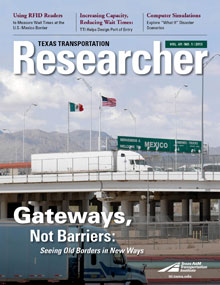Trucks crossing between Mexico and the United States at Otay Mesa, near San Diego, Calif., sometimes wait six hours during peak travel periods. Among the busiest ports of entry in the nation, Otay Mesa’s wait times are expected to increase substantially over the next decade. Longer wait times can often mean increased shipping costs for producers, and idling trucks contribute to air pollution around border towns. So it came as little surprise that a feasibility study conducted in 2008 indicated “a new border crossing must be part of a 21st century approach.”
Scheduled for completion this decade, the proposed new port of entry, Otay Mesa East, will be a state-of-the-art tolled crossing facility designed to accommodate future growth. The new port is a collaborative project among the California Department of Transportation, the Federal Highway Administration, the U.S. General Services Administration, U.S. Customs and Border Protection (CBP) and the San Diego Association of Governments.
Currently, the projected $650 million project is in the planning stages, which include an intelligent transportation systems (ITS) pre-deployment study, led by the IBI Group. The Texas A&M Transportation Institute (TTI) is a member of the IBI team.
“This project gives us a perfect opportunity to work with a clean slate to deploy and assess the numerous operating concepts and technologies that will make up this facility,” says Project Manager Don Murphy of IBI. “As part of our team we’ve turned to TTI and its expertise with border-crossing wait-time technologies and operational systems.”
Over the last decade, TTI has worked with various border-crossing technologies for existing ports of entry. This is the first project for TTI researchers on a planned border crossing.
“TTI’s main role is in developing a concept of operations,” says Juan Villa, manager of TTI’s Mexico City Office and part of the group working with IBI. “The team will help determine which technologies would be best suited for this project, how the information will flow between stakeholders, and how best to link the border information system to the local traffic management systems.”
The ITS technologies for Otay Mesa East include the collection of real-time border-crossing wait times on both sides of the border as part of an advanced traveler-information system for the region. The information will include toll rates that fluctuate depending on congestion conditions.
Among the ITS systems planned for the new border crossing are:
- data collection/analysis,
- toll-revenue collection,
- traveler-information display,
- traffic management/monitoring,
- vehicle management/monitoring,
- vehicle safety-inspection support and
- CBP operational assistance.
“The congestion around this busy region is costing everyone time and money and is deteriorating air-quality conditions,” says TTI Associate Research Engineer Rajat Rajbhandari. “Otay Mesa East provides us with a great opportunity to help build an ITS system from the ground up and, in doing so, make a real difference in the quality of life for the millions of people who live, work and travel here.”




